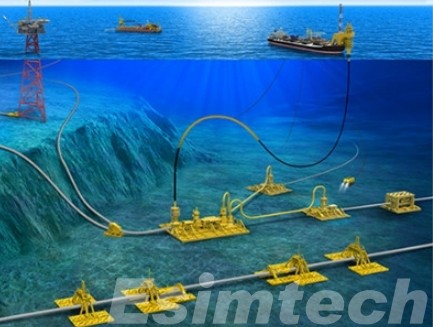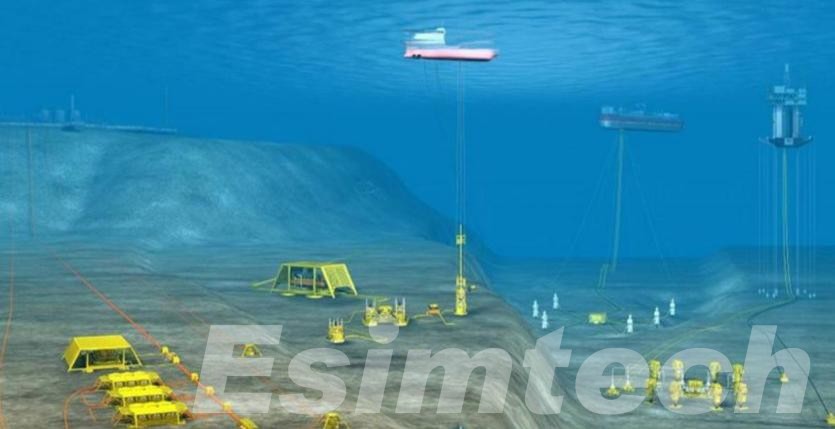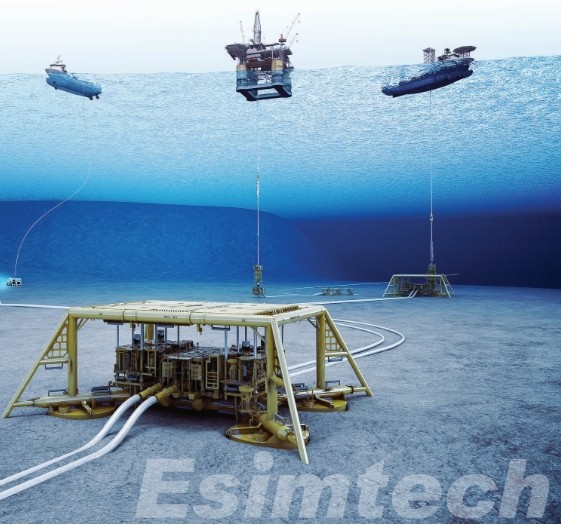What are Subsea Pipelines: How to Design and Operate Efficiently
Subsea pipelines play a crucial role in the transportation of oil and gas from offshore fields to processing facilities on land or to floating production storage and offloading (FPSO) units. With the increasing focus on deepwater and ultra-deepwater exploration, subsea pipelines are becoming increasingly critical for the development of new oil and gas reserves located in remote and challenging environments. This article discusses the importance, design considerations, challenges and future trends, related to subsea pipelines in the oil and gas industry.

Role of Subsea Pipelines in the Oil and Gas Industry
Subsea pipelines are integral to the offshore oil and gas supply chain. These pipelines are designed to transport oil, natural gas, and produced water from offshore platforms to processing plants, refineries, or storage facilities. They are typically used in deepwater and ultra-deepwater developments where traditional pipelines cannot be easily installed due to the challenging conditions of the seabed.
The main functions of subsea pipelines include:
- Transporting hydrocarbons: These pipelines deliver oil, gas, and associated fluids to processing units, typically from offshore fields to onshore facilities or offshore FPSOs.
- Produced water management: Subsea pipelines are used to transport produced water, which is a byproduct of oil and gas extraction, to treatment or disposal systems.
- Enhancing offshore field development: With the growing exploration of offshore fields, subsea pipelines enable the expansion of oil and gas operations to deeper, more remote locations.

Key Design Considerations for Subsea Pipelines
Designing subsea pipelines for the oil and gas industry involves a meticulous process that ensures the pipeline’s functionality, longevity, and safety in the harsh underwater environment. The pipelines are subjected to extreme conditions, including high pressures, low temperatures, and corrosive marine environments, making it crucial to consider various factors during the design phase.

1. Material Selection
Material selection is one of the most important aspects of subsea pipeline design, as the materials must withstand harsh environmental conditions. Some of the factors influencing material selection include:
- Corrosion Resistance: Subsea pipelines are exposed to seawater, which is highly corrosive. Therefore, materials such as carbon steel with protective coatings, corrosion-resistant alloys, and stainless steel are commonly used to resist corrosion.
- Strength and Durability: The pipeline material must have mechanical strength to handle internal pressures from the transported fluids as well as external pressures from the surrounding water, especially at deeper depths.
- Temperature Resistance: Subsea environments often experience low temperatures, and materials should be chosen for their ability to perform in extreme cold without becoming brittle.
- Flexibility: In deeper waters, the pipeline needs to be flexible enough to withstand dynamic forces, such as ocean currents and seabed movement.
2. Hydrostatic Pressure and Internal Pressure
- External Hydrostatic Pressure: As the pipeline is submerged in deep water, it is subjected to increasing external pressures with depth. The design must account for these pressures to avoid deformation or collapse of the pipeline.
- Internal Pressure: The pressure exerted by the transported fluids (oil, gas, or water) must also be taken into account. The pipeline must be designed to withstand high internal pressures without rupturing or leaking.
To ensure the pipeline can withstand both internal and external pressures, wall thickness is often increased, or advanced materials with high tensile strength are selected.
3. Thermal Considerations
- Temperature Variation: Subsea pipelines can be subjected to significant temperature gradients, from the cold temperature of the surrounding water to the hot temperature of the fluids inside the pipeline. This can lead to thermal expansion or contraction of the pipeline material.
- Insulation: To maintain the temperature of the transported fluids and prevent the pipeline from freezing or the contents from solidifying, insulation materials are applied to subsea pipelines. These materials help maintain optimal flow conditions and prevent blockages caused by solidified hydrocarbons.
4. Pipeline Routing and Geotechnical Studies
- Seabed Topography: The route of the pipeline is influenced by the seabed’s topography. Geotechnical surveys and seabed mapping are essential for identifying the most efficient and safe routing options. The pipeline must avoid areas with high seismic activity, underwater ridges, or unpredictable seabed movements.
- Seabed Stability: It is critical to evaluate the stability of the seabed along the pipeline’s proposed route. Areas of unstable sediment or shifting seabed could threaten the integrity of the pipeline, requiring special anchoring or burial techniques.
5. Pipeline Burial and Protection
- Pipeline Burial: In areas where external risks, such as fishing activities, anchor damage, or icebergs, are a concern, the pipeline is often buried in a trench beneath the seabed. This protects the pipeline from external forces and environmental factors.
- Protective Coatings: Coatings such as concrete weight coatings, asphalt, or polyurethane are used to provide additional protection against corrosion, marine organisms, and external physical damage.
- Trenching and Installation Methods: The choice of trenching technique, whether plowing, jetting, or mechanical cutting, depends on seabed composition and pipeline size. The design must account for these methods to ensure the pipeline is securely laid and protected.
6. Flow Assurance
Flow assurance is a crucial consideration in subsea pipeline design, ensuring the steady transport of hydrocarbons without blockages or disruptions. Key factors affecting flow assurance include:
- Hydrate Formation: Hydrates (solid crystalline structures that form in gas-rich pipelines at low temperatures) can block pipelines. To prevent this, design considerations include the use of thermal insulation, chemical inhibitors, and heating systems.
- Wax Deposition: In some oil pipelines, wax can precipitate out of the oil and clog the pipeline. Insulation or chemical additives can help mitigate this issue.
- Sludge and Solid Particle Flow: The design may include features to prevent the buildup of solid particles or sludge, which can reduce the efficiency of flow.

7. Seismic and Environmental Considerations
- Seismic Activity: In regions with seismic activity, the pipeline must be designed to withstand potential seismic events that could shift the seabed or cause pipeline rupture. This may involve designing flexible sections or using materials that can absorb the seismic forces.
- Marine Life and Environmental Impact: The environmental impact of the pipeline must be minimized. For example, wildlife protection mechanisms may need to be considered, particularly in areas with sensitive marine life.
- Environmental Monitoring: Continuous environmental monitoring systems, including leak detection and pipeline integrity monitoring, are integral to ensuring the pipeline’s safety and reducing environmental risks.
8. Pipeline Integrity and Maintenance
- Monitoring Systems: Incorporating real-time monitoring systems, such as fiber-optic sensors or ultrasonic sensors, into the pipeline design can help detect leaks, deformations, or other structural issues early, ensuring quick responses to potential problems.
- Inspection and Maintenance: Regular inspection through Remotely Operated Vehicles (ROVs) and Autonomous Underwater Vehicles (AUVs) is essential for maintaining the pipeline’s integrity, especially in deepwater environments.
- Pigging Systems: Pigging involves the use of devices (called pigs) to clean and inspect pipelines. Subsea pipelines may be designed to accommodate these pigs, which help remove debris and prevent the buildup of materials inside the pipeline.
9. Regulatory and Safety Considerations
- Compliance with Standards: The design must adhere to international standards and regulations, such as those set by the American Petroleum Institute (API), the International Maritime Organization (IMO), and other local regulatory bodies. These regulations ensure that the pipeline is safe, environmentally compliant, and operationally efficient.
- Safety Features: The design should incorporate emergency shutdown systems, leak detection systems, and pressure relief mechanisms to address potential safety hazards.
10. Cost and Economic Feasibility
- Capital and Operating Costs: The cost of materials, installation, and maintenance must be carefully considered to ensure the project’s economic feasibility. Advanced technology and high-performance materials may increase the initial capital cost, but they can also extend the pipeline’s lifespan and reduce operating costs in the long term.
- Risk Analysis: Economic assessments also involve evaluating potential risks, including environmental damage, damage to infrastructure, and potential leaks, which could result in costly repairs and reputation damage.

Challenges and Solutions in Subsea Pipeline Operations
Subsea pipelines face a variety of operational challenges due to the harsh and dynamic environment in which they operate. Overcoming these challenges requires advanced subsea engineering solutions and constant innovation to ensure pipeline integrity, efficiency, and safety. Below are the main challenges faced in subsea pipeline operations, along with their corresponding solutions.

1. Corrosion and Material Degradation
Challenge
Corrosion is one of the most significant challenges for subsea pipelines. The combination of seawater, high pressures, and low temperatures accelerates the deterioration of pipeline materials, leading to potential failures and leaks.
Solution
- Corrosion-Resistant Materials: Using materials like stainless steel, corrosion-resistant alloys, or carbon steel with protective coatings (such as concrete or epoxy coatings) can significantly reduce corrosion risk.
- Cathodic Protection: This technique involves placing a sacrificial anode on the pipeline to prevent corrosion by redirecting the corrosive current to the anode.
- Pipeline Coatings and Insulation: Special coatings (such as polypropylene) can provide an additional barrier to corrosion. Thermal insulation also prevents water-induced freezing, which can exacerbate the corrosion process.
2. Hydrate Formation
Challenge
In deepwater subsea pipelines, low temperatures and high pressures can lead to the formation of hydrates and solid compounds formed when water combines with hydrocarbons. These hydrates can block the pipeline, interrupting the flow of oil or gas.
Solution
- Heating Systems: Subsea pipelines can be equipped with electrical heating cables or inline heaters that maintain the fluid temperature above hydrate formation temperatures, preventing blockages.
- Chemical Inhibitors: Hydrate inhibitors, such as methanol or glycol, can be injected into the pipeline to prevent hydrate formation by lowering the freezing point of water.
3. Seabed Movement and Stability
Challenge
Subsea pipelines are often laid on the seabed, which is subject to shifting due to natural forces such as tides, currents, seismic activity, or even marine life activity. These movements can cause pipeline displacement, bending, or damage.
Solution
- Pipeline Burial: To protect pipelines from external forces, they are often buried in the seabed. Trenching and burial techniques ensure the pipeline remains stable and protected from mechanical impacts.
- Flexible Pipeline Design: Flexible risers and pipelines are designed to adapt to seabed movement, preventing rupture or fracture.
- Anchoring Systems: In areas where pipelines cannot be buried, anchors and weight coatings are used to secure pipelines to the seabed, preventing movement caused by currents or seismic activity.
4. Leak Detection and Monitoring
Challenge
Detecting leaks or failures in subsea pipelines can be difficult because of their remote location and the inability to directly observe the pipeline’s condition. Even small leaks can lead to significant environmental and financial consequences.
Solution
- Continuous Monitoring: Advanced monitoring systems, such as fiber-optic sensors and acoustic sensors, are used to detect changes in pressure, temperature, and vibration that may indicate a leak.
- Smart Pigging: Intelligent pigs equipped with sensors are used to inspect the pipeline’s internal condition, detecting corrosion, cracks, or blockages. Regular pigging allows for the early detection of potential problems.
- Remote Operated Vehicles (ROVs): ROVs are deployed to visually inspect subsea pipelines for physical damage, corrosion, and signs of wear.

5. Extreme Depths and Pressure
Challenge
With the increasing trend of exploring deeper waters, subsea pipelines are subjected to extremely high pressures and low temperatures. These extreme conditions can lead to material failure, fatigue, or deformation if the pipeline is not designed properly.
Solution
- Thicker Pipeline Walls: To withstand high external pressures, subsea pipelines are designed with thicker walls, stronger materials, and increased structural integrity.
- Advanced Materials: Using high-strength alloys and advanced composite materials can help the pipeline withstand extreme pressures without failure.
- Pressure Monitoring and Control: Pressure relief systems and real-time monitoring devices ensure that pipelines operate within safe pressure limits, preventing overpressure and associated damage.
6. Cost of Maintenance and Repairs
Challenge
Maintaining and repairing subsea pipelines can be challenging and costly, particularly when pipelines are located in remote or deepwater environments. The cost of mobilizing repair equipment and accessing the pipeline can be prohibitively expensive.
Solution
- Preventative Maintenance: Regular inspection and preventive maintenance reduce the need for costly repairs. Smart monitoring systems and pigging techniques help identify potential issues before they become major problems.
- Robotics and Automation: The use of ROVs and AUVs (autonomous underwater vehicles) has revolutionized subsea pipeline maintenance. These vehicles can perform inspections, repairs, and maintenance tasks remotely, reducing the need for human intervention and improving safety.
- Modular Repair Systems: Modular and pre-assembled repair systems are developed for quick installation and repairs, minimizing downtime and operational disruptions.
7. Logistical and Installation Challenges
Challenge
Installing subsea pipelines, particularly in deepwater environments, requires significant logistical coordination. The installation process involves heavy-lift vessels, specialized installation equipment, and precise positioning on the seabed.
Solution
- Advanced Installation Vessels: Specially designed vessels equipped with dynamic positioning systems and pipe-laying equipment ensure accurate and efficient pipeline installation.
- Pre-lay Surveys: Detailed geotechnical surveys and seabed mapping are conducted to identify the best route and ensure safe pipeline installation.
- Modular and Prefabricated Components: Using modular construction techniques and prefabricated pipeline sections allows for faster and more efficient installation, reducing the overall cost and time required.
8. Weather and Ocean Conditions
Challenge
Unpredictable weather and ocean conditions, including strong currents, storms, and freezing temperatures, can significantly impact the installation, operation, and maintenance of subsea pipelines.
Solution
- Weather Monitoring Systems: Real-time weather monitoring systems help anticipate adverse conditions and plan operations accordingly. This reduces the risk of operational delays or accidents.
- Flexible Pipelines: Pipelines designed with flexibility in mind can better withstand dynamic forces such as waves, currents, and temperature variations.
- Seasonal Planning: Pipeline installation and maintenance schedules are often planned around optimal weather conditions to reduce the risks associated with harsh environments.

Future Trends and Innovations in Subsea Pipelines
This chart highlights the advancements shaping the future of subsea pipelines, focusing on sustainability, efficiency and safety in the oil and gas industry.
| Trend/Innovation | Description | Benefits |
| Smart Pipelines | Integration of sensors and IoT for real-time monitoring of pressure, flow, and structural health. | Early fault detection, reduced downtime, and enhanced pipeline safety. |
| Digital Twin Technology | Creation of virtual models for simulation and predictive maintenance. | Enhanced planning, risk mitigation, and optimized maintenance schedules. |
| Hydrate and Wax Management | Innovative heating solutions, chemical inhibitors, and flow assurance techniques. | Prevention of blockages and flow interruptions in deepwater pipelines. |
| AI and Machine Learning | Application of AI for predictive analytics and anomaly detection. | Improved decision-making, proactive maintenance, and reduced operational risks. |
| Subsea Power Transmission | Advanced systems for powering subsea equipment directly on the seafloor. | Increased operational efficiency and reduced dependency on surface facilities. |
| Pipeline Burial Innovations | Advanced trenching and plowing methods for deep burial of pipelines. | Enhanced stability, protection from environmental forces, and reduced damage risks. |
| Modular and Flexible Designs | Modular pipeline components and flexible risers for dynamic environments. | Easier installation, adaptability to seabed movements, and reduced installation time. |
| Energy-efficient Operations | Adopt low-energy installation techniques and optimize pipeline designs. | Lower carbon footprint and operational costs. |
| Decommissioning Innovations | Sustainable methods for subsea pipeline decommissioning and recycling. | Reduced environmental impact and alignment with global sustainability goals. |

Conclusion
Subsea pipelines facilitates the efficient and safe transport of oil and gas from offshore fields to processing facilities. The design, construction, and operation of these pipelines present unique challenges, but technological advancements in materials, installation methods, monitoring systems, etc, continue to improve their reliability and performance. As the industry further develops to deepwater and remote locations, subsea pipelines will remain a critical element of offshore energy infrastructure.
